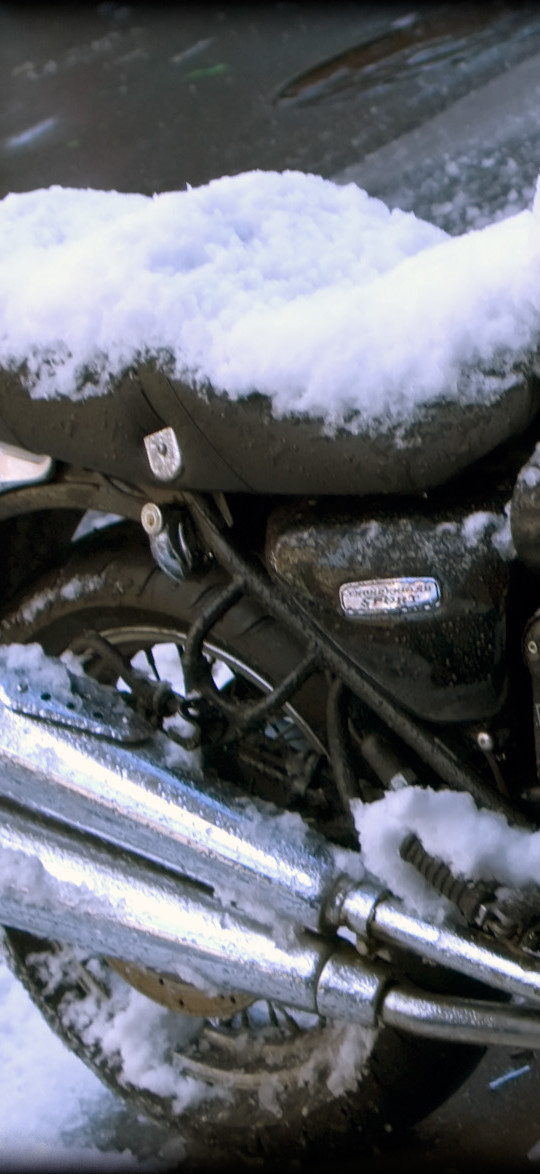So if you’re anything like me, you probably try to push the riding season about as long as your gear and pain tolerance will allow before the cold makes it too miserable to be out on the road on two wheels.

In the past, “winterizing my bike” has looked like this: after a series of terrible, dangerous rides for which I was under-dressed and emotionally unprepared, a major winter storm buries my bike in a snow bank and say “fuck it” and I leave it there until spring.
I can tell you from experience that this is not the preferred method of winterizing a motorcycle. If you have a modern fuel injected bike, you might get away with it for a season, but after a while, the weather takes its toll and the bike simply begins to to rot. Electrical connectors go bad, rust sets in, mice nest in your nice warm airbox (yes this has happened to me) and your list of spring repairs starts to spiral out of control.
If you have a carbed bike, things are even worse. One winter sitting with gas in the carbs, particularly if you have a leaky petcock, is enough to require a major overhaul.
That’s why I have compiled a brief list of recommendations to ensure that you don’t end up like me.
1. It’s worth it to find an indoor spot for your bike. I know this is hard to do in the city, but the northeast is no place to leave a bike parked on the street. The road salt and grit go everywhere, and they will begin to eat your bike alive. We have some limited storage space available at the shop, and may be able to organize more if there is interest.
2. A normal bike cover is not enough for a full winter. If you must park your bike outside for more than a month, take the time to protect it. There are some covers on the market that offer wrap around protection, including the Cycle Shell shown below. We have also figured out how to create a sealed plastic bag that fits a whole motorcycle and keeps it moisture-free for the winter.

3. Pull the battery and place it on a tender to keep it healthy. Many older bikes or bikes with lots of aftermarket accessories have a tendency to drain batteries while parked. Combine this issue with the fact that lead acid batteries bleed a bit of voltage over time, and you may end up draining the battery so low that it can’t be resurrected. Better to keep it topped up.
4. Stabilize your fuel and keep the tank full. If you can find ethanol free gas, it definitely keeps longer, but a good marine grade fuel stabilizer will take your through a winter. You also need to make sure the tank is as full as possible to avoid rust inside. When wet air has room to enter the tank, it will end up mixed into the gas and coating the inner surfaces of the tank.
5. Lube your chain and cables, wax everything, and change the oil. Basically you want as much of your bike as possible covered in some kind of protecting oily film. A dab of grease at the ferrules works great to keep water out of cables, fresh oil in the engine prevents nasty deposits that can cause damage on startup, and a clean oiled chain will prevent stuck links. Applying appropriate wax or protective oil to your tank and chrome will keep things looking fresh. Just don’t oil your brakes or your first ride next season is going to be interesting.
6. If you have carbs, keep them empty!!! You have already stabilized the fuel in the tank, and a fuel injected bike should be run for a bit to circulate the stabilizer, but the best thing for the carburetors is to be dry for the winter. Turn the petcock off and disconnect the fuel line. If you have good access, each carburetor has a drain plug that can be backed off to let the old gas out. If they are hard to reach (usually) or stripped due to a careless previous owner (almost always) you can also simply start the bike and run it till it’s out of gas. Just idling will work but it takes a long time, so I usually keep the revs up until it starts to run funny and then let it idle till it dies.
7. Take steps to keep out the vermin. Plugging the airbox and exhaust pipe is pretty much all you need to do, but I’ve also found that rodents can’t stand scented dryer sheets, and if you stick a few of them into the places a mouse might like to hide – under the seat and tank, down on top of the engine – they won’t use your bike for acorn storage.
Stay warm out there, and if you’re in DC and need help with any of this, give us a shout.

Leave a Reply